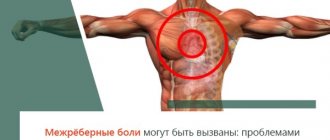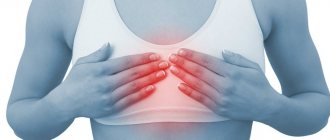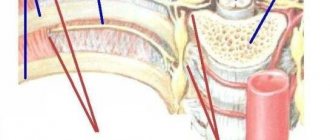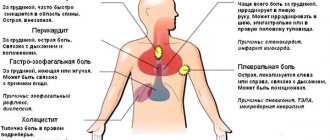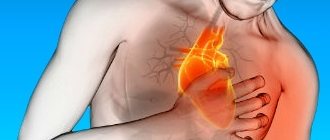Chest pain
(chest pain) is a common symptom. In many cases, chest pain can be caused by heart disease, and this makes it especially serious. However, the list of causes of chest pain is much wider. This area contains the heart, lungs, esophagus, large vessels, bones and muscles - and any of these organs can be a source of pain. Chest pain can also be caused by the diaphragm and abdominal organs, primarily the stomach. Finally, pain can be caused by problems in other organs, and its localization in the chest is explained by the complex arrangement of nerves and muscles.
Possible nature of chest pain - what you should pay attention to
Chest pain can be aching, stabbing, shooting, squeezing, burning. In some cases it can be acute, intense, even intolerable.
It is important where exactly the pain is localized. Usually the pain can be quite clearly localized as follows:
- in one half of the chest - right or left. Sometimes the localization of pain can be more specific, for example, in the ribs;
- behind the sternum. Pain behind the sternum, especially when it hurts both behind the sternum and to the left of it, is characteristic of heart disease;
- just below the sternum (in the epigastric region). Such pain is typical for diseases of the digestive tract (stomach or esophagus).
Chest pain without a clear localization may indicate lung cancer or tuberculosis.
Chest pain may be accompanied by symptoms such as:
- shortness of breath, difficulty breathing;
- cough, increased body temperature;
- weakness, cold sweat;
- belching, heartburn, nausea, vomiting;
- changes in blood pressure.
The distribution of pain is also important for diagnosis. The pain may radiate to the arm. This type of pain is observed with myocardial infarction and osteochondrosis.
How to relieve pain. First aid
Often a person who has pain in the middle of the chest does not know what to do in such a situation. Some people experience so much pain that they faint. In this case, severe fear is observed, the pulse rate increases, and the skin turns pale. The first thing to do if a person suddenly experiences severe pain in the sternum, internal organs and spine:
- call an ambulance;
- put the person in bed, slightly raising his legs;
- remove clothes that constrict the chest and interfere with breathing, give a nitroglycerin tablet, which will dilate the blood vessels and improve the condition of the victim.
Also, if a person has pain in the middle of the chest, it is best to ask everyone present to leave the room and ensure complete rest for the patient until the ambulance arrives.
Causes
Chest pain due to heart disease
Chest pain is a characteristic symptom of heart disease. It is observed, in particular, when:
- coronary heart disease (caused by insufficient oxygen supply to the heart muscle). The most common form of coronary artery disease is angina pectoris, which manifests itself in the form of discomfort, a feeling of heaviness or compressive pain behind the sternum and to the left of it. An attack of pain is usually provoked by physical activity or emotional stress. The duration of the attack usually ranges from several minutes to half an hour. Relief occurs after taking nitroglycerin. The pain may be accompanied by shortness of breath, radiating to the left arm, under the shoulder blade, and the left half of the lower jaw;
- acute myocardial infarction. Myocardial infarction is also a form of coronary heart disease that requires immediate medical attention. The pain during myocardial infarction is very intense and has a compressive, pressing or bursting character. It is observed behind the sternum and to the left of it, and can radiate to the left arm, under the shoulder blade, to the left side of the neck and lower jaw. The pain is accompanied by shortness of breath, fear of death, weakness, and cold sweat may appear. The pain lasts more than 15-30 minutes (i.e. longer than during an attack of angina) and is not relieved by nitroglycerin. If you suspect a myocardial infarction, you should immediately call an ambulance;
- pericarditis (inflammation of the outer lining of the heart - the pericardium). In this case, the pain may be constant or intermittent. It is usually localized behind the sternum. The pain increases when lying down, and decreases if you lean forward;
- myocarditis (inflammation of the heart muscle). Myocarditis occurs most often as a complication of an infectious disease. With myocarditis, chest pain is combined with fever and shortness of breath;
- mitral valve prolapse. In most cases, this disease is asymptomatic, but sometimes there is pain in the left side of the chest, which may be accompanied by a feeling of shortness of breath, a feeling of rapid or slow heartbeat, dizziness and fainting.
Chest pain due to respiratory diseases
Chest pain can occur with diseases such as:
- pleurisy (inflammation of the membrane of the lung - pleura). In case of pleurisy, the pain is usually acute and one-sided. Intensifies with deep breaths, laughter, and movement. The pain intensifies when bending to the healthy side. The pain decreases if you lie on the side where it hurts. Chest pain is combined with other symptoms - fever, chills, weakness, cough;
- pneumonia (pneumonia). Chest pain with pneumonia is a concomitant symptom that occurs against a background of cough and fever. The pain is usually one-sided - corresponds to the side on which inflammation develops. The nature of the pain is sharp or aching;
- bronchitis;
- tracheitis;
- pulmonary tuberculosis;
- lungs' cancer.
Chest pain due to diseases of the digestive tract
Pain in the chest area can be caused by diseases such as:
- stomach ulcer. With a stomach ulcer, the pain is usually described as “burning.” It is localized in the epigastric region and can radiate to the left half of the chest. Occurs after eating;
- gastroesophageal reflux disease (reflux of stomach contents back into the esophagus). Acidic or alkaline contents irritate the lining of the esophagus, causing bloating and severe pain in the epigastric region and the left side of the chest. An attack can be triggered by eating too much at night, strong coffee, or alcohol abuse. In addition to chest pain, heartburn and belching may occur;
- hiatal hernia. In most cases, the disease is asymptomatic. In some cases, aching or burning pain behind the sternum and in the epigastric region may be observed. Pain usually occurs after eating in a horizontal position. May be accompanied by hiccups, heartburn, belching, and sometimes vomiting (in obese women).
Other Possible Causes of Chest Pain
Chest pain can also be caused by:
- osteochondrosis of the cervical and thoracic spine. Pain with osteochondrosis can be similar to an angina attack and can radiate to the shoulder blade, arm, or shoulder. Sometimes there is numbness in the hand. Another option for pain with osteochondrosis is lumbago. It is provoked by turns of the body, movement of the arms, prolonged exposure to a lying position (during night sleep);
- intercostal neuralgia. In this case, the pain is usually limited to one intercostal space. The nature of the pain is “shooting”;
- shingles. The disease is caused by one of the varieties of the herpes virus. The pain is intense, burning. After 7-10 days, blistering rashes appear along the affected nerves;
- vegetative-vascular dystonia.
Spinal problems
Chest pain when inhaling often appears due to pathologies of the spinal column. The fact is that the spine contains a huge number of nerve endings, inflammation and/or infringement of which can lead to pain radiating into the chest, causing pain when inhaling.
Osteochondrosis
It is a serious disease that affects the cartilage tissue of the spinal column. The intervertebral discs thin out and become less durable, resulting in a decrease in the distance between the vertebrae. Because of this, nerve tissue is pinched, which leads to pain. If the pain intensifies when you inhale, this may indicate that the thoracic spine is affected.
Intercostal neuralgia
Sharp acute pain in the chest when inhaling occurs when compression or irritation of the nerve roots that are located between the ribs occurs. This condition can last literally a couple of minutes or drag on for a day, preventing the person from taking a deep breath and causing significant discomfort. The pain can come on suddenly, for no apparent reason, and often makes a person worry and think that the heart is stabbing, although the reason is completely different.
Fractured ribs
If you have recently been injured and experience pain in your chest when you inhale, you may suspect a rib fracture. This is a dangerous condition, and with a visit to a traumatologist
/
the surgeon
cannot hesitate, since, among other things, you may have damage to internal organs. The fracture itself, depending on its severity, can provoke additional damage.
Which doctor should I contact for chest pain?
If you have chest pain, you should first consult a general practitioner - family doctor or therapist. It is he (and not the patient himself) who should draw up the examination plan. Your GP can refer you to:
- to a cardiologist - if there is reason to believe that the pain is caused by heart disease (localized behind the sternum and to the left of it, relieved with nitroglycerin, accompanied by shortness of breath, etc.);
- see a pulmonologist if you suspect pneumonia or pleurisy (if pain is accompanied by cough and fever);
- to a gastroenterologist - if you suspect diseases of the esophagus and stomach (if the pain is accompanied by belching, heartburn, or occurs after eating);
- see a neurologist in case of “shooting” pain.
Pulmonary pathologies
There are many causes of pain in the sternum during inspiration, which are associated with pathologies of the respiratory system. It is worth considering some cases when pain may appear when inhaling.
Pneumothorax
It is an accumulation of gas in the pleural cavity, which leads to the collapse of lung tissue, from which the process occurs. In this case, the mediastinum shifts towards the healthy organ, the blood vessels are compressed, which leads to respiratory disorders, and blood circulation is also impaired. Often pneumothorax is traumatic, and can also be a consequence of spontaneous disruption of tissue integrity.
Pleuropneumonia
If chest pain appears when taking a deep breath, this may indicate progressive pulmonary pneumonia, when the pleura is involved in the pathological process. This disease is very dangerous; Along with pain when inhaling, a person notes the inability to take a deep breath and general weakness.
Pleurisy
Inflammation of the serous membrane of the lungs is called pleurisy and may be accompanied by pain when inhaling. In this case, a person not only has pain in the chest area when inhaling, but also shortness of breath, cough, pulmonologist
notes pleural friction noise when listening to breathing, and the temperature also rises.
Lungs' cancer
Pain in the middle of the chest when inhaling can occur if a malignant neoplasm has developed in the lungs. Pain syndrome is a consequence of tissue proliferation and compression of neighboring structures. To determine why your chest begins to hurt when you inhale and move, first consult a neurologist
, who, after a survey and examination, will refer you to a specialist.
What tests may be needed for chest pain?
If you complain of chest pain, the following may be prescribed to diagnose the disease:
- chest x-ray;
- computed tomography (MSCT chest);
- ECG;
- Holter monitoring (24-hour ECG monitoring);
- general blood test (allows you to determine the presence of inflammation);
- gastroscopy (if diseases of the esophagus or stomach are suspected).
stress tests (treadmill test);
Diagnostics
A comprehensive examination begins with a general practitioner or family doctor. The specialist conducts a physical examination and identifies the leading pathological syndrome, and if necessary, sends the patient for consultation with specialized specialists (pulmonologist, cardiologist). To establish a diagnosis, the results of instrumental and laboratory tests are necessary, of which the following are most often prescribed:
- X-ray of the OGK.
Radiation diagnostics helps to differentiate cardiac and pulmonary pathology. Damage to the respiratory system is manifested by focal infiltrates, rounded shadows, and increased vascular pattern. Signs of cardiac problems are changes in the size and configuration of the heart shadow, congestion in the lungs. - Electrocardiography.
An ECG evaluates the electrical activity of the myocardium. The cardiogram reveals a decrease in the voltage of the waves or their inversion, deviation of the heart axis, and signs of disturbances in the myocardial conduction system. Daily ECG monitoring and bicycle ergometer test are of great diagnostic value. - Echocardiography.
Ultrasound diagnostics shows structural and functional abnormalities in the activity of the heart. The method is necessary for diagnosing pericarditis (effusion in the heart sac), cardiomyopathy (expansion of cavities or thickening of the walls of the organ). EchoCG allows you to measure the contractile function of the left ventricular myocardium. - Invasive methods.
In case of pathological processes in the pericardium, a diagnostic puncture is performed for bacteriological and cytological examination of the exudate. In case of coronary artery disease, coronary angiography is performed to assess the extent of vascular damage. The functional state of the myocardium is determined by perfusion scintigraphy. - Laboratory diagnostics.
Analyzes are of auxiliary value. In case of cardiac pathology, an extended biochemical study is indicated with determination of the lipid spectrum and acute phase parameters, measurement of myocardial markers. Diagnosis of pulmonary diseases requires microscopy and sputum culture.
Echocardiography
